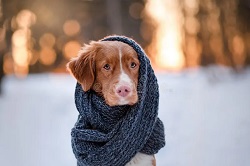Do dogs need winter coats? Yes, sometimes.
Sometimes it can get too cold for dogs to spend long periods of time outside without proper shelter and high quality nutrition.
Tolerance against the cold can vary from pet to pet based on their coat density, age, nutritional status, amount of body fat, activity level and health. Breeds with thick undercoats tend to do best. Those being, Siberian huskies, Samoyeds, Alaskan malamutes, Pyrenean Mountain Dogs Icelandic sheepdogs, Newfoundland’s, and others. But even members of these breeds need to acclimate to cold weather and are at risk during subzero temperatures.
Most dogs shouldn’t have a problem until temperatures fall below 7⁰C, when some cold-averse dogs might start feeling uncomfortable. Owners of small-breed dogs, thin-coated dogs and very young, old or sick dogs should watch their pets carefully for cold-associated health issues when temperatures dip below freezing. Once temperatures fall below -7⁰C, all owners should be aware that their dogs could develop weather-related problems such as frostbite and hypothermia.

But what about dogs who live in those areas of the country where winters can be brutally cold?
As beautiful as a dog’s coat may be, fur isn’t a perfect insulator, especially when it’s very cold. Regardless of breed, even thick- and double-coated dogs are vulnerable to cold-weather health threats such as frostbite and hypothermia.
Most frostbite danger occurs when the temperature or wind chill are near or below -17⁰C. Not that uncommon in parts of Scotland. On 30 December 1995 Altnaharra recorder -27.2⁰C. Prolonged exposure to the cold results in severe tissue damage in a dog’s extremities such as the ear tips, paws, or tail.
Hypothermia occurs when a dog’s body temperature falls below normal. The normal temperature for dogs is 38.3 to 39.2⁰C. If your dogs body temperature falls below 37.2⁰C then veterinarian advice should be take. The most common cause of hypothermia is prolonged exposure to extreme cold temperatures.
Dogs should be kept inside during cold weather and especially during extreme cold. But if you can’t keep your dog inside, he or she needs an insulated, dry shelter that’s positioned away from any prevailing wind. An appropriate kennel should be just large enough so your dog can stand up, turn around and lie down comfortably. The flooring should be off of the ground to minimize heat loss and bedding should be thick, dry and changed often. Clean, dry straw works better than towels, blankets or rugs which can absorb moisture and freeze in subzero temperatures.
Finally, dogs who spend substantial time outdoors during cold weather will need more calories, as found in Speed & Stamina, so they can produce enough body heat to keep warm. Calories may need to be increased by as much as 30%, depending on your dog, their activity level, housing and outdoor temperatures. And don’t forget to provide fresh, clean unfrozen water at all times. If you have any questions or concerns about your dog’s nutritional needs during winter months, then we are here to help.